Bloodhound SSC: How do you build a car capable of 1,000mph?
#1
Lexus Test Driver
Thread Starter
Join Date: Mar 2006
Location: Lake Ray Hubbard
Posts: 845
Likes: 0
Received 0 Likes
on
0 Posts
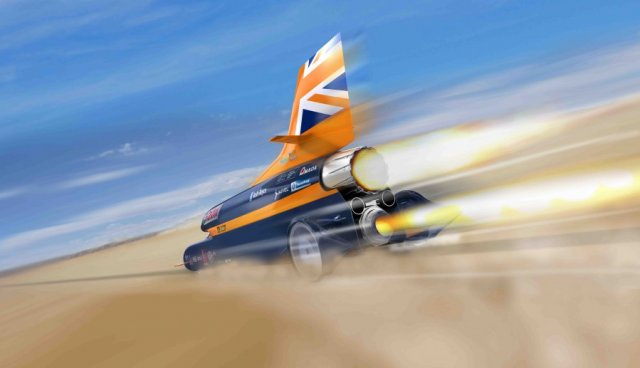
Human beings achieved many 'firsts' in the 20th century. We climbed the planet's highest mountains, dived its deepest undersea trench, flew over it faster than the speed of sound, and even escaped it altogether in order to visit the moon. Beyond visiting Mars, it may feel like there are no more milestones left to reach. Yet people are still trying to push the envelope, even if they have to travel a little farther to get there.
Richard Noble is one such person. He’s spearheading a project called Bloodhound SSC that will visit uncharted territory on its way to a new land speed record on the far side of 1,000mph. The idea of a car capable of 1,000mph might sound ludicrous at first blush, but consider Noble's credentials. The British businessman is responsible for previous land speed records in 1983 and 1997, the first of which came with him behind the wheel.
A brief history of speed
Land speed record attempts are nearly as old as the car itself. After all, it couldn't have taken long for the first motorists to wonder how fast their new contraptions might go given sufficient room. By the early 20th century, record chasers were building special cars with nothing but straight line speed in mind. These higher speeds demanded ever more power thanks to immutable laws of physics; drag (air resistance) increases as the square of speed. In plain English, a car that needs 100hp to reach 100mph would need 400hp to reach 200mph, or 900hp to reach 300mph. More power meant bigger engines, often borrowed from the aircraft industry. Noble's Bloodhound SSC is a natural progression of this trend.
Land speed cars quickly became too fast for roads or even racetracks designed for more normal cars. High speed runs need as flat a course as possible, with nothing to hit and lots of room to build up to speed and then slow down again. Suitable beaches in Wales and Florida were host to a succession of records in the 1920s, which by then had arrived at a standard format—an average of two timed runs in opposite directions, within a certain time limit (originally 30 minutes, now an hour). Speeds soon outgrew Pendine and then Daytona Beach, so attempts headed inland. In 1937, Malcolm Campbell sped across the Bonneville Salt Flats at more than 300mph, making Utah the place to go if you wanted to chase records. His car, called Blue Bird, is recognizable as a car even today. The same goes for other prewar land speed record challengers with their rubber tires and internal combustion engines. By 1947, John Cobb was knocking on the door of 400mph, but it was becoming clear that future land speed records would need more power than a piston engine could offer.
The post-war aerospace industry was being built with jet engines and rocket motors. Both were lighter and more powerful than piston engines, as speeds quickly showed. In October 1947, less than a month after Cobb's 394mph record, Chuck Yeager and Bell's rocket-engined X-1 broke the sound barrier (700mph, or Mach 1.06) for the first time. It would take 50 years for a land speed car to travel faster than Yeager's historic flight, by which time rockets had propelled X-15 pilots across the skies of the southwestern United States at 4,500mph and brought Apollo astronauts back from the moon at almost 25,000mph. Jet-powered airplanes were also soon faster than the speed of sound. By the 1950s, small fighters like the F-104 Starfighter could exceed Mach 2 (1,200mph) for short bursts, but within a handful of years, Lockheed's A-12 could cruise at Mach 3, more than 2,000mph, for as long as it had fuel.
Both rockets and jets had land speed potential, although it would take some time before either was available outside of the military. Eventually, surplus jet engines started to find their way into civilian hands, into the hands of men looking to prove they, too, had the right stuff. Between 1963 and 1964, Craig Breedlove (407mph), Tom Green (413mph, and no, not that Tom Green), and Art Arfons (434mph) duked it out on the salt flats, each taking turns at being the fastest man on earth. The following year, Breedlove returned with authority—and the engine from an F-4 Phantom—and breached 600mph. In 1970 Gary Gabelich went faster still, using rocket power rather than a jet engine. Gabelich was the last to set a land speed record at Bonneville, with a two-way average of 622mph. His record stood for 13 years, eventually bettered by just 11mph. That's where Noble comes along with a car called Thrust 2.
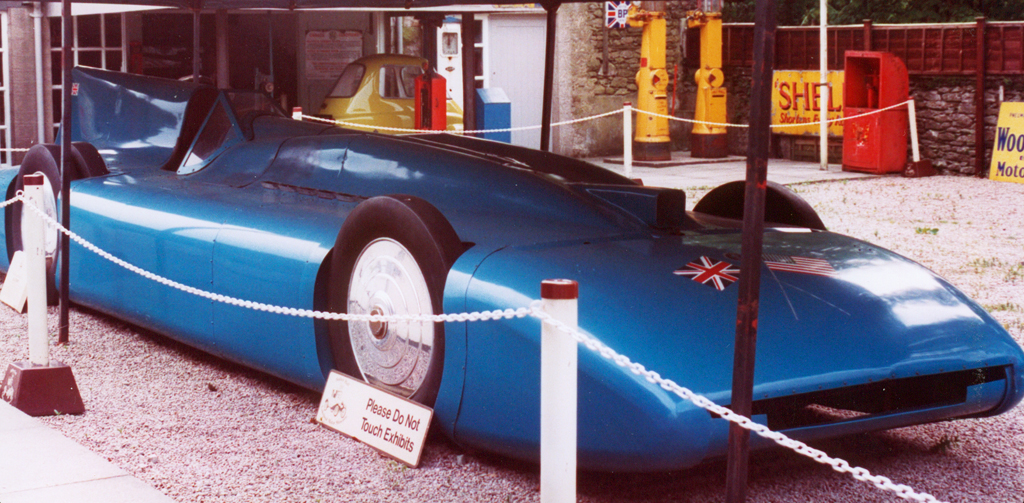
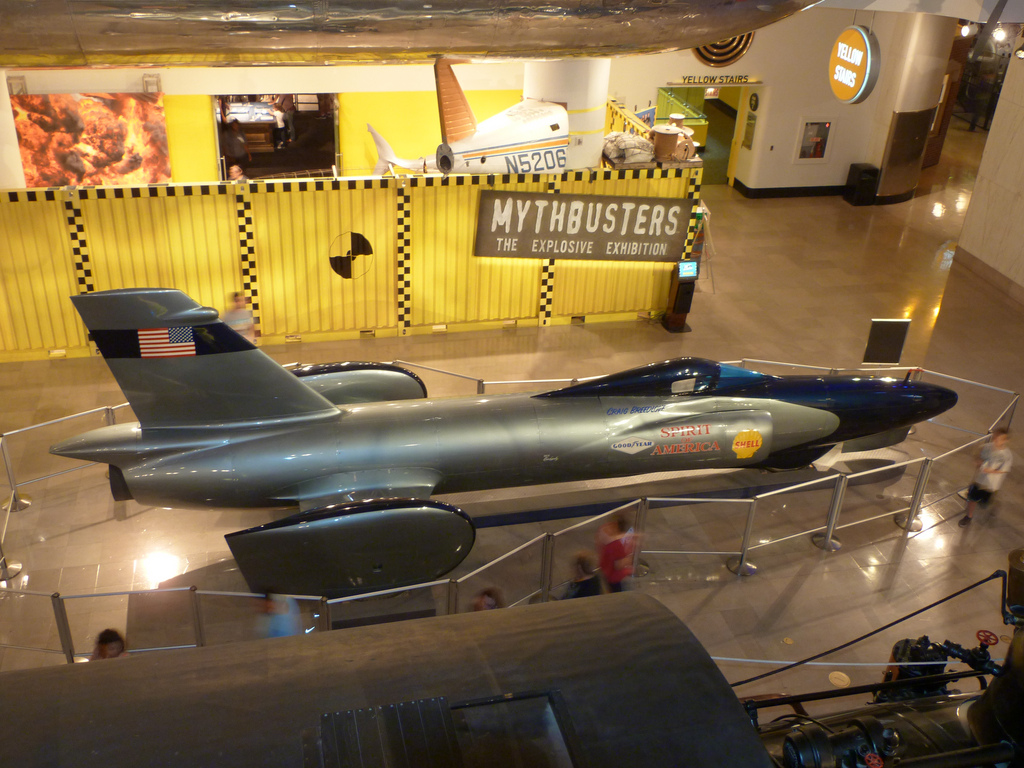
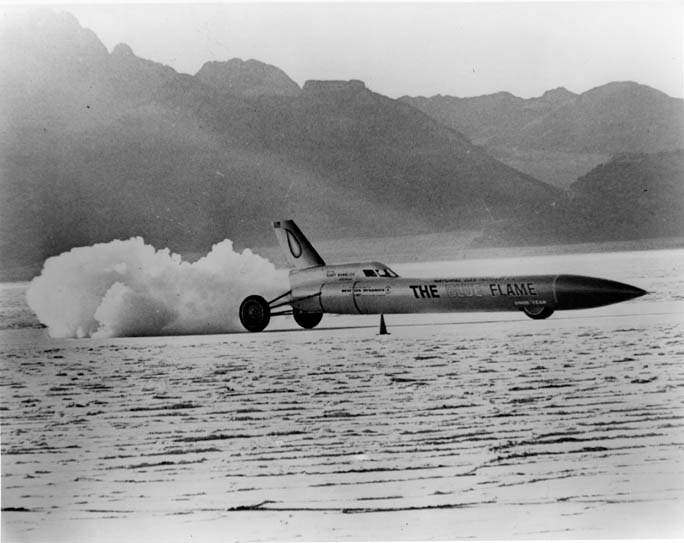


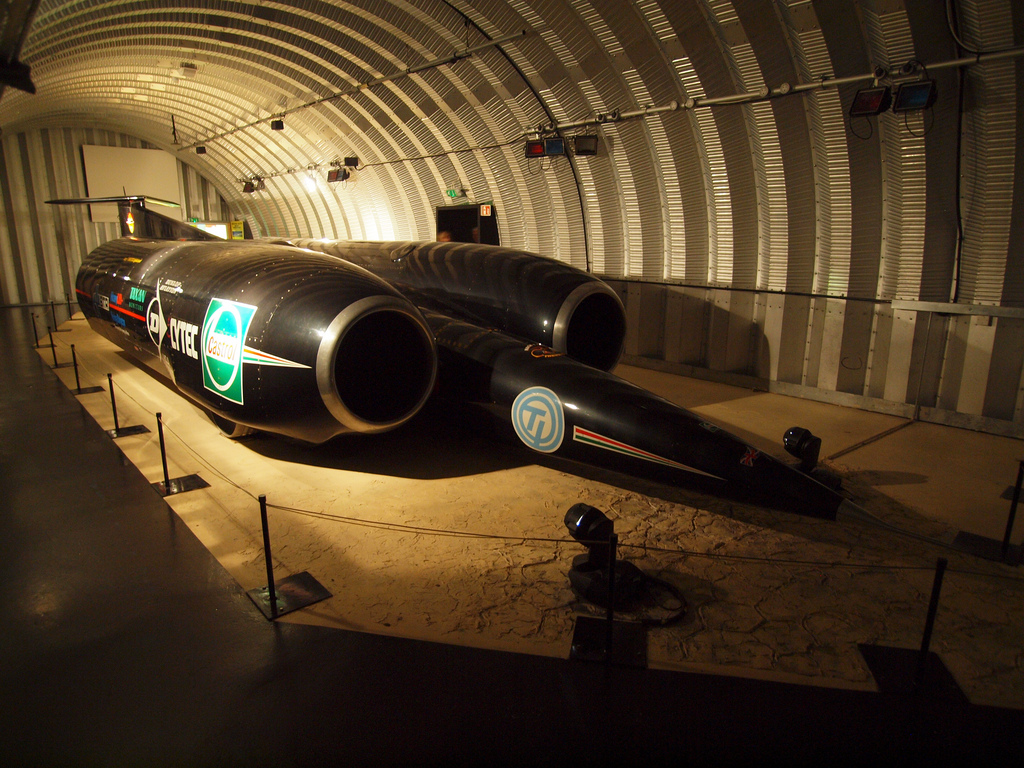
Bloodhound's ancestors
Noble had been captivated by speed as a child after watching Cobb attempt to break a water speed record on Loch Ness in Scotland. Inspired by the achievements of fellow countrymen Campbell and Cobb, he wanted to reclaim the record for Britain. After building—and then crashing—one of the UK's first jet-powered cars (Thrust 1), he acquired a surplus engine from English Electric Lightning. The Lightning was Britain's late-1950s interceptor, designed to shoot down Soviet bombers over the North Sea. It was built around two powerful Rolls Royce Avon engines that gave it astonishing performance for the time. Just one of these engines was sufficient to convince John Ackroyd to accept Noble's job offer as Thrust 2's designer, and work began on the car in 1978, albeit in a shoestring fashion.
Thrust 2, now with a more powerful variant of the Avon engine, went to Bonneville at the end of September 1981. Until now, Noble had only driven the car on runways in the UK, never faster than 260mph. For two weeks the team built up speed at Bonneville before the rain arrived, flooding the lake and ending any record attempts for the year. Thrust 2 had peaked at 500mph, but Gabelich's record would stand for a while longer. Thrust 2 returned the following September to again find Bonneville's flats under several inches of water. Once it was clear that Bonneville was no good for anything other than hovercraft, the search was on for a new location.
Noble and Thrust 2 found themselves in the Black Rock desert in Nevada, now best known as the site of the Burning Man festival. Helpfully, the surface of the alkaline playa was much better suited to Thrust 2's solid metal wheels. (At Bonneville these had cut ruts into the salt, requiring a new track for each run.) 1982 wasn't to be Thrust 2's year either, averaging 590mph and teaching Noble and his team a lot before the weather came and stopped things. Finally in 1983 everything went according to plan, and on October 4, Thrust 2 reached a peak speed of 650mph, setting a new world land speed record of 633.5mph.
It's easy to see how the mindset required to successfully break a land speed record wouldn't be satisfied just doing it once; it seems everyone comes back for another bite at the cherry. Noble was no exception. He knew that Breedlove was planning on taking back the record and that the American had a pair of General Electric J-79 engines with which to do so. 700mph was the next headline speed, with the speed of sound not much further away. Eager not to lose the record, Noble planned to defend it with Thrust 2's successor, Thrust SSC (the initials stand for SuperSonic Car).
Thrust 2's success came despite the lack of any significant aerodynamic design or refinement. Going supersonic meant that aerodynamics couldn't be ignored any longer though. In 1992, Noble met the man who would design his new car, a retired aerodynamicist called Ron Ayers. Ayers would learn much on Thrust SSC—and another land speed car, 2006's diesel-powered JCB Dieselmax—that would inform his design for Bloodhound SSC. At first though, he was reluctant to get involved. "The first thing I told him was he'd kill himself," Ayers told Ars. Yet curiosity got the better of Ayers, and he began to see solutions for the various problems that at first made this look like an impossible challenge. A second chance meeting between Noble and Ayers followed, and before long Ayers was Thrust SSC's concept designer and aerodynamicist.
Now, Ayers had the problem of working out what shape a supersonic car ought to take. That came from computational fluid dynamics (CFD). No one had attempted to use computer modeling to design a land speed record car until then, but even now no wind tunnels capable of supersonic speeds also feature a rolling road, necessary to accurately account for the effect of having wheels at those speeds. The University of Swansea in Wales created a CFD simulation of a supersonic vehicle, but "the problem was, at that time neither I nor anyone else trusted [CFD]," Ayers explained. His skepticism vanished following tests with scale models fired down a rocket sled track belonging to the UK Defense establishment (located at Pendine Sands, the site of many 1920s land speed records). The CFD data matched that from the rocket sled track to within a few percent, something that astonished both Ayers and the other aerodynamicists with whom he shared his findings.
Thrust SSC would use a pair of Rolls Royce Spey engines, taken from a British F-4 Phantom, mounted quite far forward on either side of the car, with the driver's cockpit in-between. Together with a long, pointed nose and a T-shaped tail fin and stabilizer, Thrust SSC looked much more like a jet fighter with no wings than a car. Fittingly, the car got a driver to suit its looks. Land speed records aren't cheap, something Noble (and probably every other record chaser) knew from bitter experience. He managed to scrape together enough funding to make three record attempts with Thrust 2 even though his attention was split between fund-raising and learning how to operate and control the car. For the sequel he wisely decided to leave the driving to someone else, concentrating his efforts on leading the project and raising the money. Thirty people applied for the job, a mix of drag racers and fighter pilots. The successful candidate was one of the latter, RAF Wing Commander Andy Green. Green had plenty of supersonic experience in RAF Phantoms and tornadoes; he also had a daredevil streak, evident in his choice of hobbies.
By 1997 the car was ready for Black Rock Desert. So, too, were Breedlove and his Spirit of America, setting the stage for a transatlantic, transonic shoot-out. Spirit of America narrowly escaped disaster the previous year, turning sharply right at ~675mph and rolling onto its side in the process. 1997 was to be no kinder to the Americans. On October 15, a sonic boom announced to the world that Green (backed by Noble) was now the fastest man on earth. Thrust SSC set a two-way average of 763mph, or Mach 1.015, exactly 50 years and a day after the first Mach 1 flight.
https://www.youtube.com/watch?featur...&v=zyjcN0bDpa8
Noble, Green, and Ayers set another land speed record in 2006, albeit with a much slower car. JCB Dieselmax set a new world record for a diesel-powered vehicle, reaching just over 350mph. Even though Bloodhound SSC will go much faster, Ayers told me they gathered a lot of useful knowledge then that is being applied to the current project.
Bloodhound SSC
A number of factors appear to be necessary for a land speed record attempt: a car with a sufficiently powerful engine, a suitable location, and someone motivated enough to raise the money to make it happen. A little bit of competition helps with the last of these. Breedlove, Green, and Arfons spurred each other on in the 1960s, and it was the threat of Breedlove going supersonic that sparked Thrust SSC. As you might expect, competition was also the original impetus behind Bloodhound SSC. Noble learned that Steve Fossett was planning a land speed record attempt. The ballooning adventurer bought Spirit of America from Breedlove in 2006, and he set his sights on 800mph. Noble needed a new car that incorporated the lessons learned from Thrusts 2 and SSC.
What makes the car go?
The key to any land speed record car is its engine, and Bloodhound SSC is no exception. Rather than depend on decades-old surplus, Noble and Green approached the UK government to see if they could help. "We thought we'd earned the right to do this properly with the right technology," Noble told the UK's Director magazine. The Ministry of Defense agreed on the condition that Bloodhound SSC be exciting enough a project to rekindle the interest in science and technology that Apollo or Concorde created in the 1960s and 1970s. In return for inspiring a new generation of engineers, Bloodhound SSC could have an EJ200 jet engine, a type more often found in the Eurofighter Typhoon.
https://www.youtube.com/watch?featur...&v=odi92UY25Zg
Thrust SSC needed the combined thrust of two Spey jet engines to break the sound barrier. To go 30 percent faster, Bloodhound SSC will need more power than a single EJ200 can provide—at full reheat just over 20,000lbf (90 kN), roughly as much as one of the two engines on its predecessor (albeit at half the weight). The Bloodhound team decided upon rocket power for the remaining thrust. We asked Ayers why they opted for this approach, and he explained that it had several advantages over a pair of jets. For one thing, it needs only one air intake, meaning a lower drag design than Thrust SSC's twin engines. To reach the kind of performance target Bloodhound SSC is aiming at with a pair of jets, it would require designing variable geometry air intakes. While this sort of engineering solution is used by fighter aircraft, it would add unnecessary cost, complexity, and weight to Bloodhound SSC. What's more, a rocket can provide much more thrust for its size and weight than a jet. Finally, using rocket power means being able to accelerate much more rapidly, which should help limit the length of track needed.
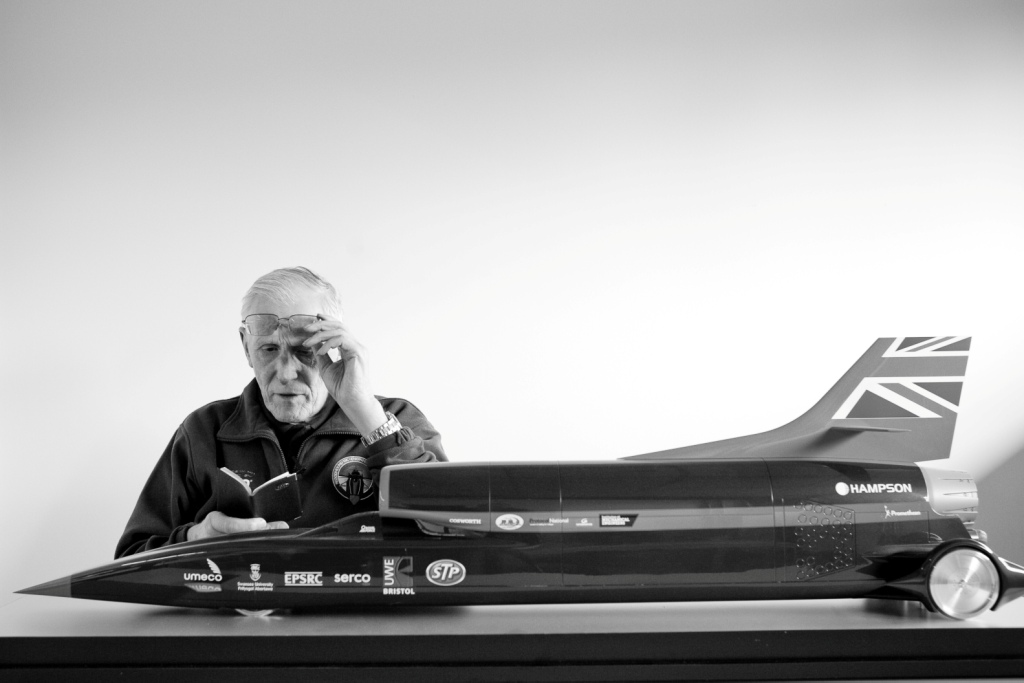
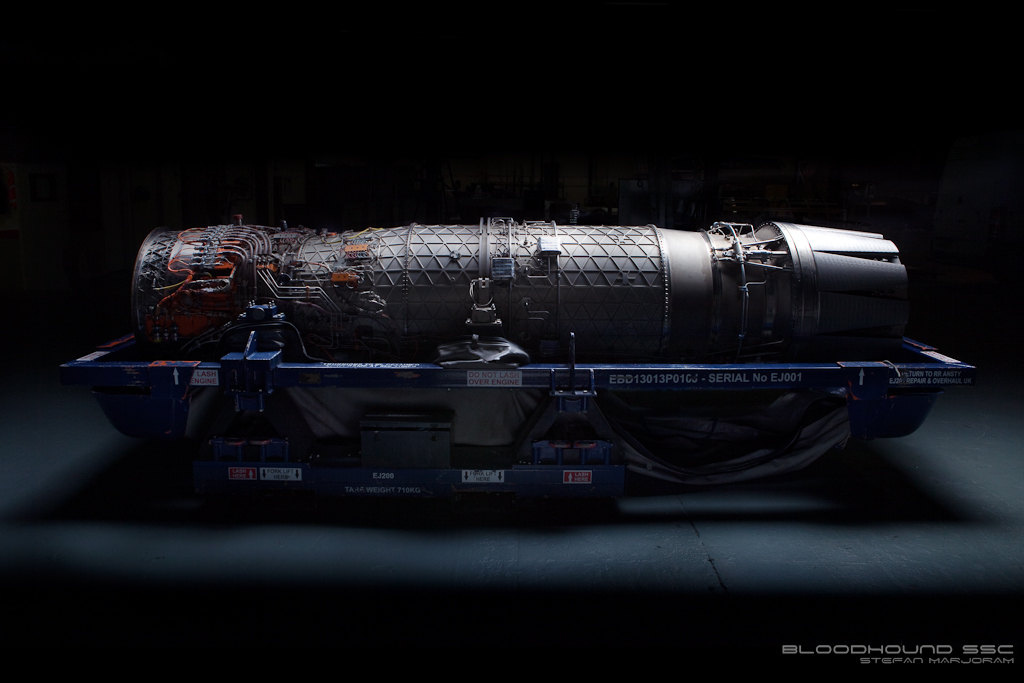


The concept behind the cluster of four hybrid rocket engines that will sit underneath the EJ200 (providing the other 27,000lbf or 122kN) is particularly interesting. Generally, rockets are either liquid- or solid-fueled. The former trade temperamental propellants for the ability to throttle their power output (by controlling the mixture of that fuel and oxidizer). Solid-fuel rockets, as their name suggests, use a combined oxidizer and fuel in a solid matrix. This makes them much more stable, but less powerful and far less controllable. Once lit, a solid-fuel rocket is going to burn until it's done.
Conventional liquid-fuel rockets—like the Dynetics F-1 that reduces Review Editor Lee Hutchinson to a quivering jelly—require a lot of intricate plumbing to pump the right mixture of fuel and oxidizer into the combustion chamber. Those propellants can be a pain to work with. The Space Shuttle's liquid oxygen and hydrogen need cryogenic storage, which is a lot easier for NASA to do at Kennedy Space Center than it would be for the Bloodhound SSC team at the remote desert in South Africa they plan to use. And liquid oxygen and hydrogen are on the mild end. Hypergolic fuels and nitric acid-based oxidizers were beloved by Soviet rocket designer Valentin Glushko for the tantalizing amount of energy they could release without the need for expensive cooling. Of course, they're extremely toxic, highly corrosive, and some of them can set fire to wet sand. It's not really surprising that they've been at the heart of some of rocketry's most catastrophic failures.
Bloodhound SSC's cluster of rockets will use a liquid oxidizer—in this case, highly concentrated hydrogen peroxide (also known as high test peroxide or HTP)—and keep the ability to be throttled. A catalyst decomposes the HTP into steam and oxygen at 1,100 degrees Fahrenheit, a temperature hot enough to ignite the fuel, which is a synthetic rubber compound. The rocket will keep firing for as long as it's fed oxygen: keep pumping in HTP and it goes, stop pumping in HTP and it stops. The pump itself is adapted from the UK's aborted Blue Steel cruise missile, and it's designed to supply the rocket with more than 10 gallons of HTP every second. That in itself is no mean feat, and the car's auxiliary power supply will need at least 750bhp to drive the HTP pump. Until recently, Bloodhound SSC's plan called for a Cosworth Formula 1 engine as that auxiliary power supply, although now several alternate arrangements are being tested.
http://"https://www.youtube.com/watc...&v=aqOVRMHI2vo
How do you build a car capable of 1,000mph?
As you might imagine, the car is built around these two engines. The front section, including the cockpit survival cell and the jet engine's air intake, is a carbon fiber monocoque, similar to a top flight race car (and now the occasional road car). The rear structure encloses both engines and their ancillaries in a chassis made from machined aluminum, steel, and titanium. Bloodhound SSC's shape is the result of extensive aerodynamic development, much more so than Thrust 2 or even Thrust SSC. The car has to be able to cut through the dense air at ground level at more than 1,000mph, and it has to be stable and controllable throughout the speed range.
Keeping a car on the ground at such high speed is quite a challenge. Both Thrust 2 and Spirit of America suffered from too much front lift at speeds above 650mph, and Noble was just 7mph away from taking off in 1983. Bloodhound SSC's shape began with a pointy oval called a Sears-Haack body, which Ayers and Ben Evans (Bloodhound's CFD engineer) then modified with intakes and exhausts. At the front, the cockpit helpfully creates a shockwave just ahead of the EJ200's air intake that precompresses the air entering the jet, something that should boost the engine's power by about 10 percent at full speed. It took several years of iterative CFD work and 12 different configurations to arrive at Bloodhound's final shape, one that should be predictable at both subsonic and supersonic speeds. Ayers' prior experience has proved highly valuable with Bloodhound SSC. For example, analyzing the data from Thrust SSC, he found that it experienced a significant amount of drag—several tons—caused by the spray of dust and particles churned up from the desert surface by the wheels. JCB Dieselmax and now Bloodhound SSC have therefore been designed with this in mind.


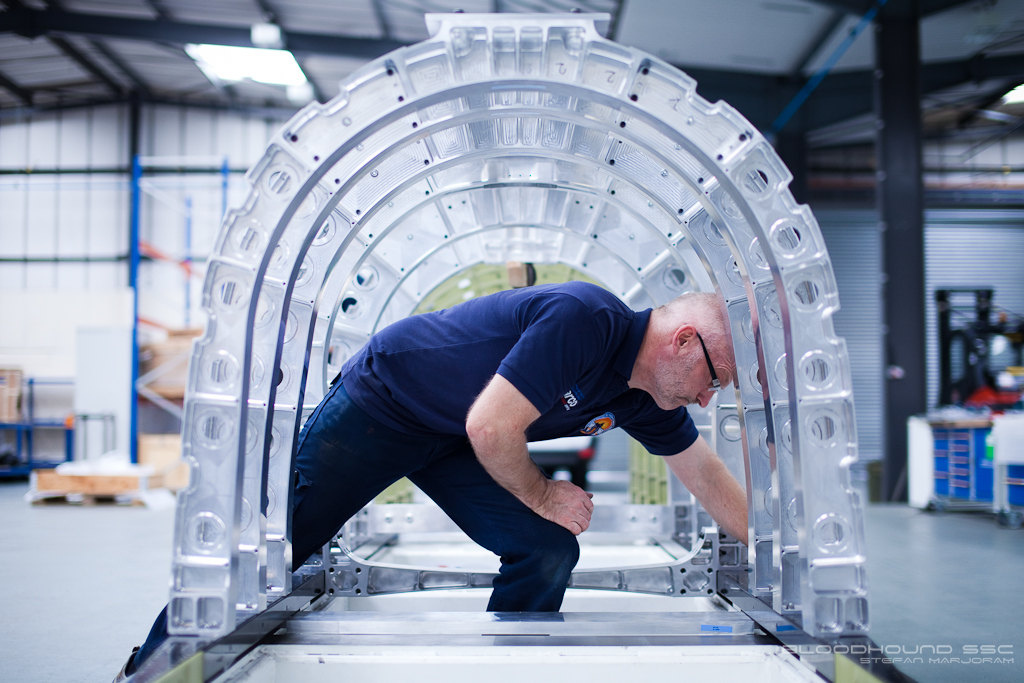


Bloodhound SSC is definitely a car, even if its shape and propulsion scream aerospace. Its wheels are solid disks of aluminum, each weighing more than 200lbs. At record-breaking speed, each wheel will become a centrifuge, subjecting the rim to the same G forces scientists use to separate DNA out of cells. Maybe a tire could be made to cope. After all, Goodyear built tires for Blue Flame that did, but allegedly didn't want them taken above 700mph. Possible or not, the issue was rendered moot by a design decision made by Bloodhound SSC's grandfather. In 1979, John Ackroyd was hard at work on the Isle of Wight designing Thrust 2 when he realized that solid metal wheels had a number of advantages. They would be lighter and stronger than conventional wheels, with no possibility of a puncture, a point proved by Thrust 2 and Thrust SSC to good effect. At 1,000mph the radial load on each of Bloodhound SSC's wheels will be ~50,000G, which is why they are forged, rather than cast, the better to withstand those forces.
Its wheels are solid, but they're still wheels, connected to the car by springs and dampers tuned to soak up the bumps—as best as possible—at 1.4 times the speed of sound. Steering a car at those speeds can be a special challenge, and for Thrust SSC, mechanical engineer Glynn Bowsher tried something new. The car was designed to be very front-heavy to aid stability. With so much weight to support, the front wheels had to be very large, and there wasn't sufficient room inside the engine pods to allow them to turn. Bowsher designed the car with rear-wheel steering instead, proving the concept with a specially modified Mini. Thrust SSC was difficult to control, something Ayers attributes both to the rear wheel steering and the shockwave created at speed that pulverized the desert as it sped across its surface.
By contrast, Bloodhound SSC has a much more conventional arrangement. Green's steering wheel controls the front wheels, the same as in your road car, although Bloodhound SSC's wheels only have five degrees of steering, a minuscule range compared to production cars. Steering the front wheels at speed requires a lot of work to counteract the strong gyroscopic effect caused by the immense G loads. A very high steering ratio of 30-to-1 means the steering shouldn't be unmanageably heavy, but the system prevents any feedback from the wheels to the driver.
Bloodhound SSC steers like a normal car, and it stops and goes like a normal car, too, sort of. There's an accelerator pedal on the right, which controls the jet engine, and a trigger on the steering wheel to control the rocket. The brake pedal is on the left, connected to disc brakes supplied by AP (pictured below). These are only going to be used to slow the car if it's below 200mph. Slowing from high speed will be the job of the car's air brake and parachute, both of which are controlled from the steering wheel like the rocket. Ayers' hope is that the air brake alone will be sufficient to slow the car down to 100mph, but even if it does, it seems prudent to build in some redundancy for what is, after all, a rather important aspect of the car's performance.

Where are they going to drive 1,000mph?
Finding a stretch of land long enough and flat enough for Bloodhound SSC was not particularly simple. Bonneville and other salt flats were out. Thrust 2's solid wheels had cut into the hard salt crust, so each run would require the team to mark out a fresh track. Both of Bloodhound SSC's solid-wheeled predecessors ran on the softer alkali playa of Black Rock desert to good effect, but Black Rock, too, was ruled out, as the playa's surface degraded by years of drought and heavier use (Burning Man, take a bow). Wherever the team picked had to have an expanse of smooth, flat land at least 12 miles long and three wide. It couldn't rain or flood at inappropriate times; the last thing a project like this wants is to spend time, effort, and money to travel out into the back of beyond only to stand around for weeks waiting for it to stop raining. The car, the crew, and lots of boxes of stuff will have to be shipped there from the team's Bristol, UK headquarters, so the site can't be too remote or belong to people who don't want them there.
Fittingly, the solution was arrived at computationally, just like the car's aerodynamics. A Swansea University Professor, Adrian Luckman, used these criteria (and a few more) plus topographic data from the Shuttle Radar Topography Mission and elsewhere to find 36 possible sites across the world, some already having been used by previous land speed record attempts. After further refinement to the list, Green visited some of the more promising sites during 2008 and 2009 before the project settled on the Hakskeen Pan, located in South Africa's Northern Cape province near the Namibian border.
Needless to say, it's not as simple as just flying the car and crew to South Africa and then going for it. A course will have to be laid out, marked by parallel lines 50' apart. Before each run, volunteers have to walk the entire length of the course and remove any loose rocks or stones to prevent them being sucked into an engine or otherwise damaging Bloodhound SSC. Given the length involved, this is no small task, but it is vitally important. Breedlove's 1997 record hopes were destroyed along with his engine when Spirit of America ingested something solid at more than 600mph.
What happens next?
The car has to be completed before Noble, Green, and the rest of the Bloodhound SSC team can try and ****** the record. According to Noble, the first attempt should happen next year. Expect the group to succeed, but perhaps not on the first try. Almost every successful land speed record has required multiple attempts, and it's unlikely that Bloodhound SSC will buck that trend. Ayres has planned out a test program that should see the car reaching 800 to 850mph in 2015, and then coming back the following year to hit 1,000mph. As with Thrust SSC (or an experimental aircraft), the idea is to build up to speed incrementally, ironing out bugs and problems as they inevitably crop up.
The rocket engine's design has to be finalized before Green has the power to hit 1,000mph. The car's structures are now at a relatively advanced stage, which means the final rocket cluster is going to have to be designed to fit the car. Ayers isn't particularly worried though, and he thinks the team is well equipped with solutions to potential engineering problems.
He also thinks it's possible they won't be the first to beat Thrust SSC. Six other land speed record projects are underway, some more serious than others. Ayers tells Ars that the stiffest competition should come from Rosco McGlashan's Aussie Invader. He describes that car as being "a bit like a Saturn launcher, but on its side." While the Bloodhound SSC team welcomes the competition that brings, Ayers remains confident the British car will be the first to 1,000mph.
Thread
Thread Starter
Forum
Replies
Last Post





